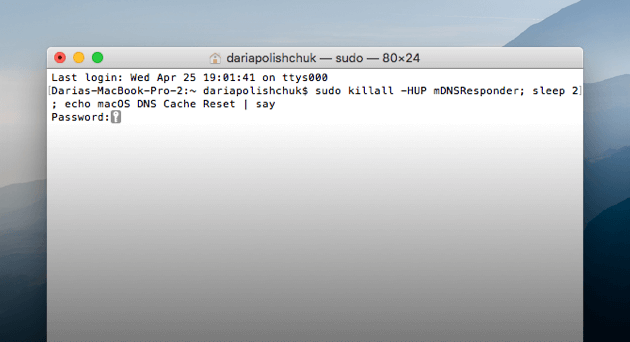The latest version of Flush Memory can be downloaded for Mac OS X 10.6 or later. The following versions: 1.1 and 1.0 are the most frequently downloaded ones by the program users. The actual developer of this software for Mac is Paola Petrelli & Giorgio Vinciguerra. Flush Memory for Mac lies within System Tools, more precisely System Optimization.
- Step 1, Close as many open programs as possible. Open programs use files from the 'Cache' folder, so you won't be able to remove as many cached files as you like if you have multiple programs open.Step 2, Go to your Mac's Finder. Do this by clicking on your Desktop image or on the blue smiley-face icon on the far left in your Dock.Step 3, Click Go. It's in the menu bar at the top of the screen. A drop-down menu will appear.
- Aug 31, 2020 Simply type down your Mac OS user password and press return With that, you’ll have reset and flush the DNS Cache. Even if the entire process runs successfully, you won’t receive any confirmation message or such. To see if the process was a success, you can try and run a dig or nslookup on a website that you want.
- How to flush the DNS cache in Mac OS X El Capitan and Yosemite. Both systems can flush the DNS cache in the following ways. Open the Finder and go to Applications Utilities Terminal. Enter the following syntax at the command line: sudo dscacheutil -flushcache;sudo killall -HUP mDNSResponder;say cache flushed 3.
- Apr 30, 2018 Flushing the cache simply updates the entry on your Mac that corresponds to the server address. Next time you try to access this server i.e., a website, it will load a bit slower —which is similar to clearing your browser cache. What are the alternatives to flushing the DNS cache on Mac?
Some browsers and devices store website location data in your system for quicker access to the DNS Cache. DNS Cache needs to be flushed to remove stored website location details. Here are some of the common ways to flush your DNS cache.
DNS, or a Domain Name System, is primarily what resolves website names into their respective IP addresses. So, if you are encountering an issue on your Mac where the name server is not resolving properly, or if you want a DNS change to be noticed by your system, you might have to reset and flush the DNS cache in macOS Catalina. This can also come in handy if you have made edits to your /etc/hosts file, and you want the changes to register without having to reboot your Mac. So,if you want to reset and flush the DNS cache on your Mac os Catalina, follow below steps to know how to do it.
Reset and Flush/Clear DNS Cache in macOS Catalina
Flush Mac Os Dns
The process to reset and flush or clear DNS cache in macOS Catalina is actually very easy. All it requires is for you to enter one command in the Terminal, and you’re done. Well, technically, it’s two commands in one line. If you want to flush DNS cache on a Mac, simply follow the steps below:
1. Launch Terminal, and type below command first.
2. Then it will ask to enter a password. Enter your Mac login password and hit Enter.
3. If everything goes right then you have successfully reset, and flushed the DNS cache on macOS Catalina. If you were encountering any issues with name servers, and such, they should now get resolved. You can try and do a “dig“, or an “nslookup” on a website you want, to see if your DNS issues have resolved.
Reset and Flush DNS Cache DNS Issues [Fixed]
You can reset and clear DNS cache in macOS Catalina to fix most DNS issues that you might be facing. The method mentioned in the article works for Mac OS X 10.10, and even on macOS Catalina. If you face any issues with the commands I mentioned, feel free to let me know in the comments section down below.

Mac OS X – Clearing or flushing the DNS Cache is regular occurrence for a network engineer.
Once you go to a Web site, or do any DNS lookup, the IP gets cached for quite a while. This becomes a royal pain if youíre a systems administrator who is in the middle of migrating domains from one server to another. Executing the following clears the cache, restarts the caching daemon, and fetches fresh DNS records.
And there was much rejoicing
Flush Dns On Mac Os
For OS X Yosemite
For Mountain Lion / Lion
For Leopard
sudo dscacheutil -flushcache
For Tiger
lookupd -flushcache
(On Windows you do ipconfig /flushdns)
Reference: Apple Support Site here